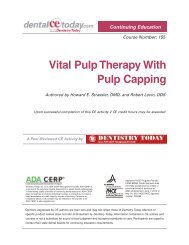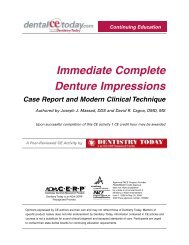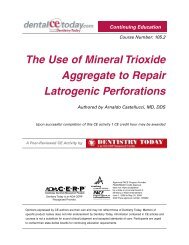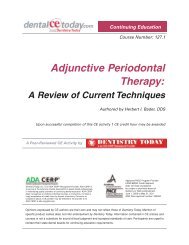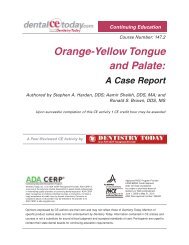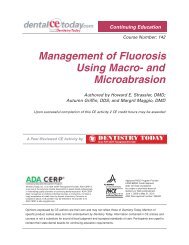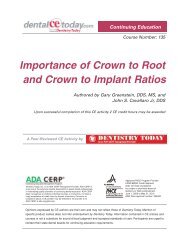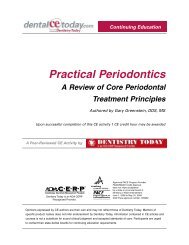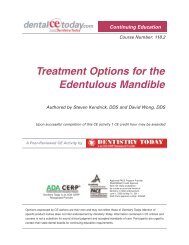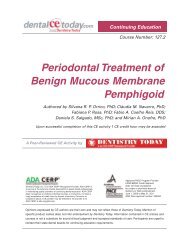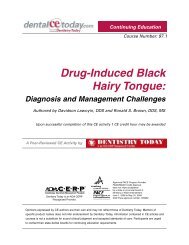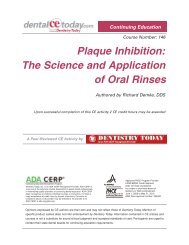The Modified Grassline Technique: A Case Report - DentalCEToday
The Modified Grassline Technique: A Case Report - DentalCEToday
The Modified Grassline Technique: A Case Report - DentalCEToday
Create successful ePaper yourself
Turn your PDF publications into a flip-book with our unique Google optimized e-Paper software.
Continuing Education<br />
Course Number: 147.1<br />
<strong>The</strong> <strong>Modified</strong> <strong>Grassline</strong><br />
<strong>Technique</strong>:<br />
A <strong>Case</strong> <strong>Report</strong><br />
Authored by Arthur R. Volker, DDS, MSEd, and Gerald S. Wank, DDS<br />
Upon successful completion of this CE activity 1 CE credit hour may be awarded<br />
A Peer-Reviewed CE Activity by<br />
Dentistry Today, Inc, is an ADA CERP Recognized Provider. ADA CERP is<br />
a service of the American Dental Association to assist dental professionals<br />
in indentifying quality providers of continuing dental education. ADA CERP<br />
does not approve or endorse individual courses or instructors, nor does it<br />
imply acceptance of credit hours by boards of dentistry. Concerns or<br />
complaints about a CE provider may be directed to the provider or to<br />
ADA CERP at ada.org/goto/cerp.<br />
Approved PACE Program Provider<br />
FAGD/MAGD Credit Approval<br />
does not imply acceptance<br />
by a state or provincial board of<br />
dentistry or AGD endorsement.<br />
June 1, 2009 to May 31, 2012<br />
AGD Pace approval number: 309062<br />
Opinions expressed by CE authors are their own and may not reflect those of Dentistry Today. Mention of<br />
specific product names does not infer endorsement by Dentistry Today. Information contained in CE articles and<br />
courses is not a substitute for sound clinical judgment and accepted standards of care. Participants are urged to<br />
contact their state dental boards for continuing education requirements.
Continuing Education<br />
<strong>The</strong> <strong>Modified</strong> <strong>Grassline</strong> <strong>Technique</strong>:<br />
A <strong>Case</strong> <strong>Report</strong><br />
Effective Date: 03/1/2012 Expiration Date: 03/1/2015<br />
LEARNING OBJECTIVES<br />
After participating in this CE activity, the individual will learn:<br />
• A technique for the conservative orthodontic movement<br />
of periodontally involved teeth.<br />
• Factors to be considered before orthodontic treatment of<br />
compromised teeth.<br />
ABOUT THE AUTHORS<br />
Dr. Volker graduated from the Columbia<br />
University School of Dental and Oral<br />
Surgery. He received a Fellowship from<br />
the AGD and is the chairman of the New<br />
Dentist Committee and a member of the<br />
Continuing Education Com mittee for the<br />
New York State AGD. He is a clinical attending at the Coler-<br />
Goldwater Specialty Hospital and Nursing Facility in<br />
Roosevelt Island, NY, and is in private practice in Queens,<br />
NY. He can be reached via e-mail at volkerdds@gmail.com.<br />
Disclosure: Dr. Volker reports no disclosures.<br />
Dr. Wank is a clinical professor of<br />
periodontics and implantology at the New<br />
York Uni versity College of Dentistry. He has<br />
received Fellowships in the American<br />
College of Dentists, International College<br />
of Dentists, American Academy of Oral<br />
Medicine, New York Academy of Dentistry, American Public<br />
Health Association, and AGD. He is a consultant in<br />
periodontics at the New York Veteran’s Hos pital, as well as a<br />
consultant in perio-ortho-prosthodontics at Coler-Goldwater<br />
Specialty Hospital and Nursing Facility in Roosevelt Island, NY.<br />
Dr. Wank is an international lecturer and has published in<br />
many peer-reviewed journals. He can be reached via e-mail at<br />
gwank@aol.com.<br />
Disclosure: Dr. Wank reports no disclosures.<br />
INTRODUCTION<br />
<strong>Grassline</strong> threads were used for the noninvasive<br />
intermittent movement of malposed teeth from the 1940s to<br />
the 1980s. 1 Derived from the ramie plant, grassline is a<br />
heavily twisted fiber that shrinks when exposed to fluids.<br />
Un fortunately, grassline is no longer commercially<br />
available. Recently, Lohmiller 2 de mon strated a modified<br />
version of the technique whereby heavily twisted 100%<br />
cotton crochet thread of varying sizes and composite<br />
“holds,” which function similarly to orthodontic brackets, can<br />
be used as a suitable substitute.<br />
Once thought to be a contraindication to orthodontic<br />
therapy, periodontal disease is no longer a barrier to<br />
comprehensive treatment, although special considerations<br />
must be employed. 3,4 <strong>The</strong> determination of primary versus<br />
secondary trauma to the patient’s dentition must also be<br />
addressed. 5 Primary trauma results in periodontal damage<br />
from excessive occlusal loading on a healthy peridontium,<br />
such as a “high” restoration left unresolved. Secondary<br />
occlusal trauma occurs when nonexcessive masticatory<br />
forces result in periodontally-compromised teeth being put<br />
into occlusal over-function. Since these teeth no longer<br />
possess the alveolar structural support to withstand what<br />
was once normal loading, routine function becomes a<br />
damaging force. This loading can come from the opposing<br />
dentition as well as soft tissue, particularly the habitual<br />
thrusting of the tongue on the lingual surfaces of anterior<br />
teeth. Pathologic movements of these teeth can easily<br />
occur. 6,7 As such, retention management after the<br />
completion of treatment is of paramount importance. 8<br />
<strong>The</strong> inherent advantage of grassline and the modified<br />
cotton thread technique is that they deliver force<br />
intermittently. When exposed to oral fluids, there is a finite<br />
shrinkage to the cotton threads, approximately 3% to 10%<br />
depending on its thickness and processing treatment. 9 As<br />
a result, movement of the treated teeth occurs<br />
incrementally, as these teeth are held at their new position<br />
until the next tie sequence is to be performed. This<br />
utilization of an intermittent force as opposed to a<br />
continuous force, such as that found in elastics or springs,<br />
provides advantages for the periodontally in volved<br />
dentition. It has been shown that the use of intermittent<br />
orthodontic forces resulted in less root resorption than oc -<br />
1
curred with continuous forces<br />
in periodontally compromised<br />
teeth. 10-12<br />
<strong>The</strong> following case report<br />
discusses the application of a<br />
modified grassline technique to<br />
the periodontally compromised<br />
patient.<br />
a<br />
Continuing Education<br />
<strong>The</strong> <strong>Modified</strong> <strong>Grassline</strong> <strong>Technique</strong>: A <strong>Case</strong> <strong>Report</strong><br />
b<br />
CASE REPORT<br />
A 55-year-old white female with no significant contributory<br />
medical history presented with a chief complaint of, “I have<br />
big spaces between my lower front teeth” (Figures 1a to 3).<br />
<strong>The</strong> patient reported that she had orthodontic treatment as<br />
an adolescent and ad mitted to habitual tongue thrusting.<br />
Ad di tionally, she claimed to be a nocturnal bruxer and had<br />
worn a maxillary nightguard intermittently for the past<br />
20 years.<br />
An orthodontic examination revealed a bilateral Class II,<br />
division II occlusal relationship, with a 40% vertical overbite, 2<br />
mm horizontal overjet, and no maxillary midline discrepancy.<br />
Incisal wear was noted on the lower anterior incisors<br />
and wear facets were noted on posterior teeth. Additionally,<br />
large fractured buccal portions of teeth Nos. 3, 19, and 30<br />
were observed. A periodontal assessment revealed clinical<br />
plaque and calculus, as well as 2 to 3 mm pocketing of<br />
anterior teeth with bleeding upon probing. Radiographs<br />
revealed 40% to 60% bone loss of mandibular anterior<br />
teeth with a widened periodontal ligament interproximally<br />
(funneling) (Figure 4).<br />
<strong>The</strong> patient was made fully aware that realignment of<br />
the mandibular an terior teeth without subsequent treatment<br />
of the maxillary teeth would result in an increased overjet.<br />
<strong>The</strong> pa tient was unwilling to undergo comprehensive<br />
orthodontic treatment which would involve possible<br />
extraoral anchorage and/or bilateral bicuspid extraction. In<br />
addition, the patient was made aware that further labial<br />
tipping of the mandibular anterior teeth from tongue<br />
thrusting would lead to further periodontal compromise,<br />
including an increased loss of keratinized gingival<br />
attachment as well as buccal bone.<br />
<strong>The</strong> proposed course of orthodontic treatment was to<br />
use the crochet thread to bring the mandibular anterior<br />
Figures 1a and 1b. Initial view of patient’s malalignment.<br />
Figure 2.<br />
Initial frontal view of<br />
patient’s mandibular<br />
malalignment.<br />
Figure 3.<br />
Initial occlusal view.<br />
Figure 4.<br />
Initial periapical<br />
presentation.<br />
Note 40% to 50%<br />
bone loss of the<br />
mandibular<br />
incisors as well<br />
as widening of<br />
the periodontal<br />
ligament<br />
(funneling).<br />
teeth into alignment. Retention would then be provided by a<br />
fixed lingual splint to prevent orthodontic relapse and to<br />
negate the effects of secondary occlusal trauma and<br />
tongue thrusting.<br />
Full-mouth scaling and root planing was performed to<br />
2
maximize periodontal health prior to tooth movement.<br />
Temporary microhybrid composite (Herculite Ultra [Kerr])<br />
occlusal “buildups” on teeth Nos. 3, 19, and 30 were<br />
completed to aid in bite stabilization. Full-coverage<br />
restorations were planned for these teeth following or thodontic<br />
treatment.<br />
Using a total-etch bonding protocol, microhybrid<br />
composite “holds” were appropriately positioned on teeth<br />
Nos. 22 to 27. <strong>The</strong> holds function similarly to conventional<br />
orthodontic brackets in that they help to direct forces<br />
resulting from the contraction of the crochet thread as well<br />
as prevent slippage of the thread gingivally or incisally.<br />
Continuing Education<br />
<strong>The</strong> <strong>Modified</strong> <strong>Grassline</strong> <strong>Technique</strong>: A <strong>Case</strong> <strong>Report</strong><br />
Essentially, a ball of un cured composite was placed on the<br />
facial surface of an involved tooth. A bracket height gauge<br />
was used to make a properly positioned indentation in the<br />
composite and held in position against the tooth during<br />
curing. Rough edges and excess composite impeding<br />
placement of the thread were subsequently removed. A<br />
typo dont representation of the technique is shown in<br />
Figures 5a to 5d.<br />
<strong>The</strong> 100% cotton heavily twisted crochet thread (Mez)<br />
was tied around the indicated teeth in the manner<br />
prescribed by Wank 1 (Figures 6a to 6j). <strong>The</strong> initial ties were<br />
completed with size 20 thread, as the larger the thread size,<br />
a b c d<br />
Figures 5a to 5d. Demonstration on typodont for placement of composite “holds.”<br />
a b c d<br />
e<br />
f<br />
g<br />
h<br />
i<br />
j<br />
Figures 6a to 6j.<br />
Tie sequence for thread placement.<br />
3
Continuing Education<br />
<strong>The</strong> <strong>Modified</strong> <strong>Grassline</strong> <strong>Technique</strong>: A <strong>Case</strong> <strong>Report</strong><br />
the greater the shrinkage, and subsequently, the greater<br />
the amount of tooth movement. Every 7 to 10 days, the ties<br />
were replaced, and the positioning of ties depended on the<br />
movement needed (Figures 7 and 8). As interdental<br />
spacing decreased and teeth moved into a more optimal<br />
position, smaller threads were tied as less movement was<br />
needed. Thread placement was also managed to allow for<br />
ideal interproximal closure (Figures 9 and 10). After 12<br />
weeks of treatment, which consisted of 10 thread changes,<br />
the desired positioning was obtained (Figure 11).<br />
A 0.010” x 0.020” stainless steel annealed ribbon-wire<br />
was bonded utilizing a total-etch technique and microhybrid<br />
composite (Herculite Ultra) as a fixed lingual retainer from<br />
teeth Nos. 22 to 27 (Figure 12). Periodic observation of<br />
these teeth is planned to determine if functional or<br />
parafunctional forces cause any movement from the final<br />
position. Should this occur, circumferential splinting would<br />
be provided. 13 A postoperative radiograph reveals<br />
resolution of funneling of the periodontal ligament and<br />
evidence of bone apposition (Figure 13).<br />
Figure 10. Occlusal<br />
view of treatment<br />
progression after<br />
10 weeks. Note the<br />
thread positioning<br />
to allow for interproximal<br />
space<br />
closure.<br />
Figure 11.<br />
Final frontal view<br />
after 12 weeks of<br />
treatment, which<br />
consisted of 10<br />
thread changes.<br />
Figure 12.<br />
Final occlusal view<br />
after placement of<br />
fixed lingual<br />
retainer.<br />
Figure 7.<br />
Midtreatment ties.<br />
Note how the<br />
composite “holds”<br />
maintain the<br />
position of the<br />
threads.<br />
Figure 8.<br />
Progression of<br />
tooth movement<br />
after 10 weeks. As<br />
interdental space<br />
was closed, smaller<br />
threads were<br />
placed.<br />
Figure 13.<br />
Periapical radiograph<br />
demonstrating<br />
evidence of bone<br />
apposition.<br />
Figure 9.<br />
Occlusal view<br />
of treatment<br />
progression after<br />
6 weeks.<br />
CONCLUSION<br />
Several methods of applying interim forces are available for<br />
orthodontic therapy. Examples include clear aligners (eg,<br />
Invisalign) and modified removable elastic acrylic combos<br />
4
(pseudo intermittent forces).<br />
However, they generally have a<br />
higher laboratory cost associated<br />
with their use compared to the<br />
thread technique described here.<br />
Other advantages, as well as<br />
disadvantages of the technique,<br />
are described in the Table.<br />
<strong>The</strong> use of the modified<br />
grassline technique can be a<br />
safe and effective treatment<br />
modality, particularly for those<br />
patients who are compromised periodontally.<br />
Acknowledgement<br />
<strong>The</strong> authors would like to express their gratitude to Mr. Frank<br />
Pavel, assistant director of the Medical Library at Coler-<br />
Goldwater Specialty Hospital and Nursing Home, and Dr.<br />
Fred Cook, professor, School of Polymer, Textile & Fiber<br />
Engineering at the Georgia In stitute of Technology, for their<br />
help in the preparation of this article.<br />
REFERENCES<br />
1. Wank GS. <strong>The</strong> use of grassline ligature in periodontal<br />
therapy. Dent Clin North Am. 1972;16:473-486.<br />
2. Lohmiller RM. <strong>Modified</strong> grassline technique for<br />
orthodontic space closure. Eur J Esthet Dent.<br />
2006;1:30-51.<br />
3. Re S, Corrente G, Abundo R, et al. Orthodontic<br />
treatment in periodontally compromised patients:<br />
12-year report. Int J Periodontics Restorative Dent.<br />
2000;20:31-39.<br />
4. Feng X, Oba T, Oba Y, et al. An interdisciplinary<br />
approach for improved functional and esthetic results<br />
in a periodontally compromised adult patient. Angle<br />
Orthod. 2005;75:1061-1070.<br />
5. Wank GS, Kroll YJ. Occlusal trauma. An evaluation<br />
of its relationship to periodontal prostheses. Dent Clin<br />
North Am. 1981;25:511-532.<br />
Continuing Education<br />
<strong>The</strong> <strong>Modified</strong> <strong>Grassline</strong> <strong>Technique</strong>: A <strong>Case</strong> <strong>Report</strong><br />
Table. Advantages and Disadvantages of the <strong>Modified</strong> <strong>Grassline</strong> <strong>Technique</strong><br />
ADVANTAGES<br />
Intermittent forces<br />
Cost<br />
Aesthetically more pleasing than<br />
metal brackets<br />
Decreased trauma to oral tissues<br />
compared to brackets<br />
DISADVANTAGES<br />
<strong>Technique</strong> sensitive<br />
Ties must be changed every<br />
7 to 10 days<br />
Thread may untie or tear<br />
Not as effective in patients with<br />
healthy peridontium<br />
6. Geiger AM. Malocclusion as an etiologic factor in<br />
periodontal disease: a retrospective essay. Am J<br />
Orthod Dentofacial Orthop. 2001;120:112-115.<br />
7. Towfighi PP, Brunsvold MA, Storey AT, et al.<br />
Pathologic migration of anterior teeth in patients with<br />
moderate to severe periodontitis. J Periodontol.<br />
1997;68:967-972.<br />
8. Greenstein G, Cavallaro J, Scharf D, et al. Differential<br />
diagnosis and management of flared maxillary<br />
anterior teeth. J Am Dent Assoc. 2008;139:715-723.<br />
9. Heap SA, Greenwood PF, Leah RD, et al. Prediction<br />
of finished weight and shrinkage of cotton knits—<strong>The</strong><br />
Starfish Project: Part I: Introduction and general<br />
overview. Textile Research Journal. 1983;53:109-119.<br />
10. Ballard DJ, Jones AS, Petocz P, et al. Physical<br />
properties of root cementum: part 11. Continuous vs<br />
intermittent controlled orthodontic forces on root<br />
resorption. A microcomputed-tomography study.<br />
Am J Orthod Dentofacial Orthop. 2009;136:8.e1-8.<br />
11. Konoo T, Kim YJ, Gu GM, et al. Intermittent force in<br />
orthodontic tooth movement. J Dent Res.<br />
2001;80:457-460.<br />
12. Hayashi H, Konoo T, Yamaguchi K. Intermittent 8-hour<br />
activation in orthodontic molar movement. Am J<br />
Orthod Dentofacial Orthop. 2004;125:302-309.<br />
13. Wank GS. <strong>Modified</strong> circumferential splint for periodontally<br />
involved teeth. Dent Surv. 1976;52:40-42,49-51.<br />
5
Continuing Education<br />
<strong>The</strong> <strong>Modified</strong> <strong>Grassline</strong> <strong>Technique</strong>: A <strong>Case</strong> <strong>Report</strong><br />
POST EXAMINATION INFORMATION<br />
To receive continuing education credit for participation in<br />
this educational activity you must complete the program<br />
post examination and receive a score of 70% or better.<br />
Traditional Completion Option:<br />
You may fax or mail your answers with payment to Dentistry<br />
Today (see Traditional Completion Information on following<br />
page). All information requested must be provided in order<br />
to process the program for credit. Be sure to complete your<br />
“Payment,” “Personal Certification Information,” “Answers,”<br />
and “Evaluation” forms. Your exam will be graded within 72<br />
hours of receipt. Upon successful completion of the postexam<br />
(70% or higher), a letter of completion will be mailed<br />
to the address provided.<br />
Online Completion Option:<br />
Use this page to review the questions and mark your<br />
answers. Return to dentalcetoday.com and sign in. If you<br />
have not previously purchased the program, select it from<br />
the “Online Courses” listing and complete the online<br />
purchase process. Once purchased the program will be<br />
added to your User History page where a Take Exam link<br />
will be provided directly across from the program title.<br />
Select the Take Exam link, complete all the program<br />
questions and Submit your answers. An immediate grade<br />
report will be provided. Upon receiving a passing grade,<br />
complete the online evaluation form. Upon submitting<br />
the form, your Letter Of Completion will be provided<br />
immediately for printing.<br />
General Program Information:<br />
Online users may log in to dentalcetoday.com any time in<br />
the future to access previously purchased programs and<br />
view or print letters of completion and results.<br />
POST EXAMINATION QUESTIONS<br />
1. Advantages of the modified grassline technique<br />
include:<br />
a. Intermittent forces.<br />
b. Cost.<br />
c. Aesthetically more pleasing than metal brackets.<br />
d. All of the above.<br />
2. What are common sequelae of pathologic labial<br />
tipping of the mandibular anterior teeth?<br />
a. Loss of gingival attachment.<br />
b. Loss of buccal bone.<br />
c. Loss of lingual bone.<br />
d. Both a and b.<br />
3. How often does the grassline tie get replaced?<br />
a. Every 2 months.<br />
b. Every month.<br />
c. Every 7 to 10 days.<br />
d. Every other day.<br />
4. Secondary occlusal trauma results from:<br />
a. Nonexcessive masticatory forces resulting in<br />
periodontally compromised teeth being placed into<br />
occlusal over function.<br />
b. Nonexcessive masticatory forces resulting in<br />
nonperiodontally compromised teeth being put into<br />
occlusal over function.<br />
c. Excessive occlusal loading on a healthy peridontium.<br />
d. Nonexcessive occlusal loading on a healthy<br />
peridontium.<br />
5. Which orthodontic modalities employ an intermittent<br />
force?<br />
a. Spring.<br />
b. Elastics.<br />
c. <strong>Grassline</strong>.<br />
d. Both a and b.<br />
6. What is an inherent advantage of using intermittent<br />
orthodontic forces over the use of continuous<br />
orthodontic forces?<br />
a. Reduced occlusal loading on opposing dentition.<br />
b. Increased likelihood of root resorption.<br />
c. Reduced likelihood of root resorption.<br />
d. Reduced total treatment time.<br />
7. Why are composite “holds” placed on the teeth<br />
during treatment?<br />
a. To aid in direction of forces.<br />
b. To function as a torque multiplier.<br />
c. To prevent incisal or gingival slippage of the thread<br />
during movement.<br />
d. Both a and c.<br />
8. Using a larger cotton thread size will result in:<br />
a. Decreased movement.<br />
b. Increased movement.<br />
c. Increased fracture resistance of composite “holds.”<br />
d. Both a and c.<br />
6
Continuing Education<br />
<strong>The</strong> <strong>Modified</strong> <strong>Grassline</strong> <strong>Technique</strong>: A <strong>Case</strong> <strong>Report</strong><br />
PROGRAM COMPLETION INFORMATION<br />
PERSONAL CERTIFICATION INFORMATION:<br />
If you wish to purchase and complete this activity<br />
traditionally (mail or fax) rather than online, you must<br />
provide the information requested below. Please be sure to<br />
select your answers carefully and complete the evaluation<br />
information. To receive credit you must answer at least 6 of<br />
the 8 questions correctly.<br />
Complete online at: dentalcetoday.com<br />
TRADITIONAL COMPLETION INFORMATION:<br />
Last Name (PLEASE PRINT CLEARLY OR TYPE)<br />
First Name<br />
Profession / Credentials<br />
Street Address<br />
Suite or Apartment Number<br />
License Number<br />
Mail or fax this completed form with payment to:<br />
Dentistry Today<br />
Department of Continuing Education<br />
100 Passaic Avenue<br />
Fairfield, NJ 07004<br />
Fax: 973-882-3622<br />
City State Zip Code<br />
Daytime Telephone Number With Area Code<br />
Fax Number With Area Code<br />
E-mail Address<br />
PAYMENT & CREDIT INFORMATION:<br />
Examination Fee: $20.00 Credit Hours: 1.0<br />
Note: <strong>The</strong>re is a $10 surcharge to process a check drawn on<br />
any bank other than a US bank. Should you have additional<br />
questions, please contact us at (973) 882-4700.<br />
❏ I have enclosed a check or money order.<br />
❏ I am using a credit card.<br />
My Credit Card information is provided below.<br />
❏ American Express ❏ Visa ❏ MC ❏ Discover<br />
ANSWER FORM: COURSE #: 147.1<br />
Please check the correct box for each question below.<br />
1. ❏ a ❏ b ❏ c ❏ d 5. ❏ a ❏ b ❏ c ❏ d<br />
2. ❏ a ❏ b ❏ c ❏ d 6. ❏ a ❏ b ❏ c ❏ d<br />
3. ❏ a ❏ b ❏ c ❏ d 7. ❏ a ❏ b ❏ c ❏ d<br />
4. ❏ a ❏ b ❏ c ❏ d 8. ❏ a ❏ b ❏ c ❏ d<br />
Please provide the following (please print clearly):<br />
Exact Name on Credit Card<br />
Credit Card #<br />
Signature<br />
Approved PACE Program Provider<br />
FAGD/MAGD Credit Approval<br />
does not imply acceptance<br />
by a state or provincial board of<br />
dentistry or AGD endorsement.<br />
June 1, 2009 to May 31, 2012<br />
AGD Pace approval number: 309062<br />
/<br />
Expiration Date<br />
Dentistry Today, Inc, is an ADA CERP Recognized<br />
Provider. ADA CERP is a service of the American<br />
Dental Association to assist dental professionals in<br />
indentifying quality providers of continuing dental<br />
education. ADA CERP does not approve or endorse<br />
individual courses or instructors, nor does it imply<br />
acceptance of credit hours by boards of dentistry.<br />
Concerns or complaints about a CE provider may be<br />
directed to the provider or to ADA CERP at<br />
ada.org/goto/cerp.<br />
PROGRAM EVAUATION FORM<br />
Please complete the following activity evaluation questions.<br />
Rating Scale: Excellent = 5 and Poor = 0<br />
Course objectives were achieved.<br />
Content was useful and benefited your<br />
clinical practice.<br />
Review questions were clear and relevant<br />
to the editorial.<br />
Illustrations and photographs were<br />
clear and relevant.<br />
Written presentation was informative<br />
and concise.<br />
How much time did you spend reading<br />
the activity and completing the test?<br />
7



